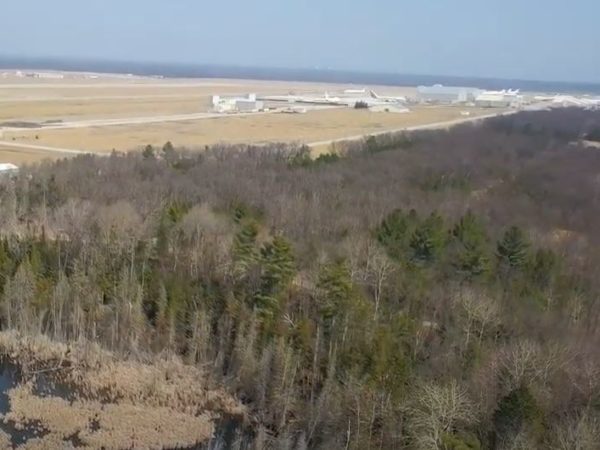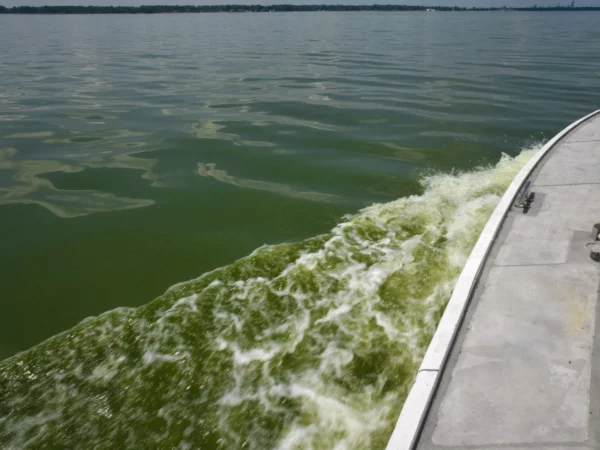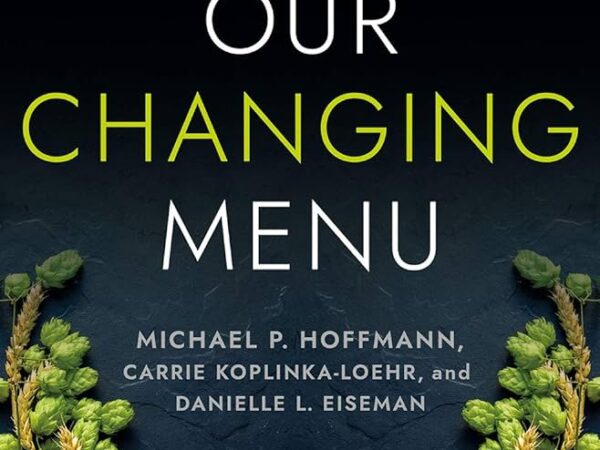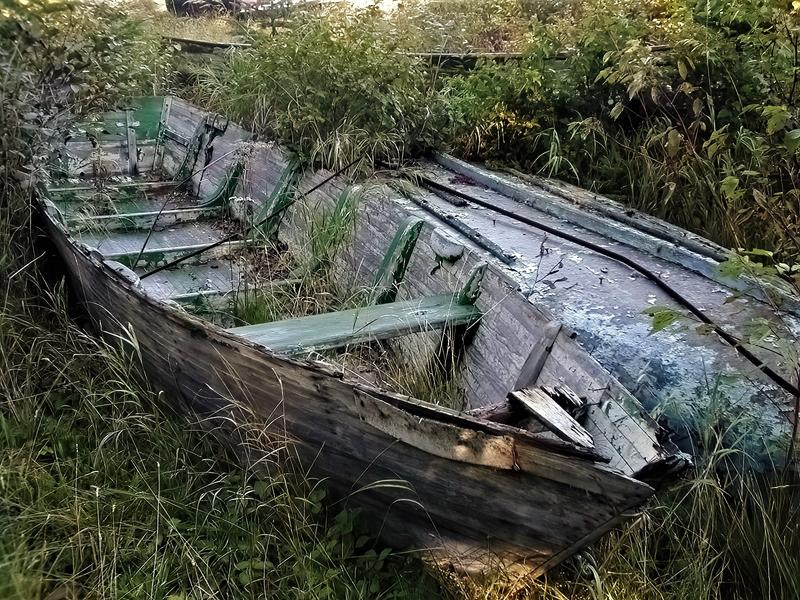
By Lester Graham, Michigan Radio
The Great Lakes News Collaborative includes Bridge Michigan; Circle of Blue; Great Lakes Now at Detroit Public Television; and Michigan Radio, Michigan’s NPR News Leader; who work together to bring audiences news and information about the impact of climate change, pollution, and aging infrastructure on the Great Lakes and drinking water. This independent journalism is supported by the Charles Stewart Mott Foundation. Find all the work HERE.
The downtown office for the Sault Sainte Marie Tribe of the Chippewa Indians Fisheries Management Program is a simple, small two-story brick building. But you don’t have to guess whether you’re in the right place. Pickup trucks with the tribe’s Natural Resources Services emblem are usually parked at the side of the building and sometimes in front.
Brad Silet is a bearded man with a broad smile who looks the part of an outdoorsman. He’s the lead Fisheries Biologist for the Sault Tribe.

Brad Silet is the Fisheries Biologist for the Sault Ste. Marie tribe of the Chippewa Indians. (Photo Credit: Lester Graham/Michigan Radio)
He is greatly concerned about the whitefish population in Lake Superior as well as in Lakes Michigan and Huron.
“That is our main fish species in Anishinaabe culture. That is the fish species that is most important throughout our creation history,” he said.
The Great Lakes are warming. For the coldest and largest of the lakes, Lake Superior, that could mean a lot of changes. Researchers are still sorting out what the future might be, but a lot of it doesn’t look good.
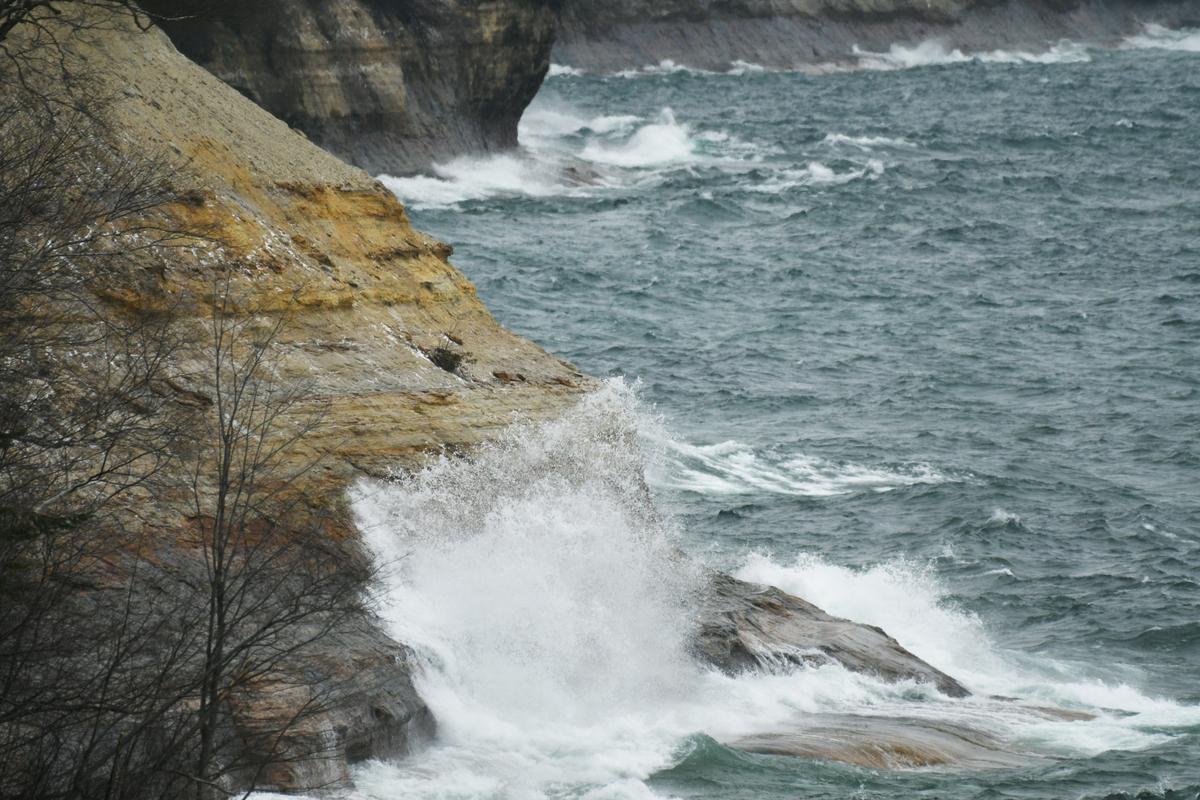
Waves of Lake Superior crashing against the rocks at higher levels than ever seen in recorded history. (Photo Credit: Lester Graham/Michigan Radio)
One change Silet is worried about is the volatility of the lake levels.
“When you start doing these really drastic up and down water levels, you start seeing a lot more of those negative impacts potentially to the hatching of those eggs,” he said.
That’s because whitefish spawn in rocky coastal areas. When water levels drop, spawning grounds can be disrupted. During the winter, ice can scour the spawning grounds and damage eggs.
“If the projections are what they are appearing for climate change, we may be going into a sort of bad situation with the ability for whitefish eggs or even lake trout eggs to be able to survive,” Silet said.
API key not valid. Please pass a valid API key.Big storms on the big lake
Lake Superior is not just warming; it’s warming faster than its surroundings.
Jay Austin and a colleague published a study on Lake Superior warming about 15 years ago. Austin is a faculty member at the Large Lakes Observatory at the University of Minnesota, Duluth.
Whitefish Point Lighthouse just before a storm. (Photo Credit: Lester Graham/Michigan Radio)
“We looked at summer surface water temperature increasing — and at the time it was only 25 years but the message remains today with an extra 15 years of data — was faster than the change in air temperature,” he said.
Climate change is affecting Lake Superior in some volatile ways. Its surface temperature has been going up, but with wild fluctuations. The average wind speeds have been increasing 5 percent each decade since 1980.
And Superior has been pounded by three 500-year to one 1,000-year storm events in the past eight years.
“If it’s not climate change, what is it?” asked Peter Annin, who has documented the effects of climate change in his recently revised book Great Lakes Water Wars.
“I mean, that we have the largest lake in the world by surface area is not just seeing one extreme event, it’s seeing a series of scientifically documented extreme events that are creating a pattern that is changing the relationship that human beings are having with the Great Lakes that they love,” he said.
The ups and downs of the Great Lakes
The effects people are talking about now are the historically high lake levels of the Great Lakes. But it wasn’t that long ago that people were concerned about historically low water levels.
The two most significant things that affect the water levels of the lakes are precipitation and evaporation.
“In 1998, Lake Superior’s temperature went up about two degrees Celsius (3.6 Fahrenheit) and it stayed there,” said Drew Gronewold, hydrologist at the University of Michigan’s School of Environment and Sustainability.
It stayed warm for more than 15 years. Gronewold said typically there’s more of a balance between precipitation and evaporation, but during that period evaporation was well above average and it dominated the hydrologic cycle of the Great Lakes, keeping water levels low.
Then the rains came. Gronewold said changes in how moisture is carried from the oceans and dumped into the Great Lakes region are also consistent with climate change. Add to that some cold weather, and things changed dramatically.
A view looking at islands just south of Isle Royale in Lake Superior. (Photo Credit: Lester Graham/Michigan Radio)
“In 2014, there was what we call in the media, the polar vortex, and lake temperatures went down by an order of one or two degrees Celsius and all of a sudden evaporation rates were low,” Gronewold said. “So those changes in temperatures that you’re talking about, they are of a big magnitude and they have a huge impact on the hydrology and the physics of the lakes.”
And because Lake Superior is so big, it has a kind of a temperature memory. A super-cold winter means there will be a cool summer because a lot of heat energy has left the lake and it doesn’t come back immediately. So, there’s less evaporation over the summer.
You might be thinking ‘That’s not warming; that’s cooling’
The planet is warming. The regional effects caused by global warming fluctuate dramatically, but the trend does point to warming over decades.
Gronewold said weather in the Great Lakes region can vary dramatically by something as simple as the jet stream moving north or south by 100 miles and taking warmer or colder air with it. So regional weather will be sporadic, but over the decades the mean temperature of the area is still trending higher.

Eagle Harbor lighthouse in the Keweenaw Peninsula of Michigan on Lake Superior. (Photo Credit: Lester Graham/Michigan Radio)
It’s normal for the Great Lakes water levels to rise and fall over the years. They have throughout recorded history. However, things are changing.
“What’s different now is that we’re seeing an increase in extremes, an increase in higher highs, lower lows, the speed with which we’re rising, the speed with which we’re falling, we’re breaking records all over the place,” said author Peter Annin.
Shorter hockey seasons, more invasive species
Eventually, there will be less ice cover on Lake Superior. Human activities and some traditions will be disrupted.
“Maybe what used to happen in March might now be happening in February or January,” said Frank Seglenieks, Water Resources Engineer with Environment and Climate Change Canada.
“You can have ice hockey tournaments that are designed to be in mid-February at, let’s say, Thunder Bay, Ontario, where they’re going to use the ice surface because traditionally that ice has been frozen and you can have your hockey tournament. Maybe now, you can’t have that tradition because the water temperature is just too high.”
Seglenieks said less ice and thinner ice might happen every five years or so at first, but it could be every other year in the not-too-distant future.
Other activities such as ice fishing and snowmobiling also might not be possible as regularly on Lake Superior. These are part of the culture of the people who live near Lake Superior.
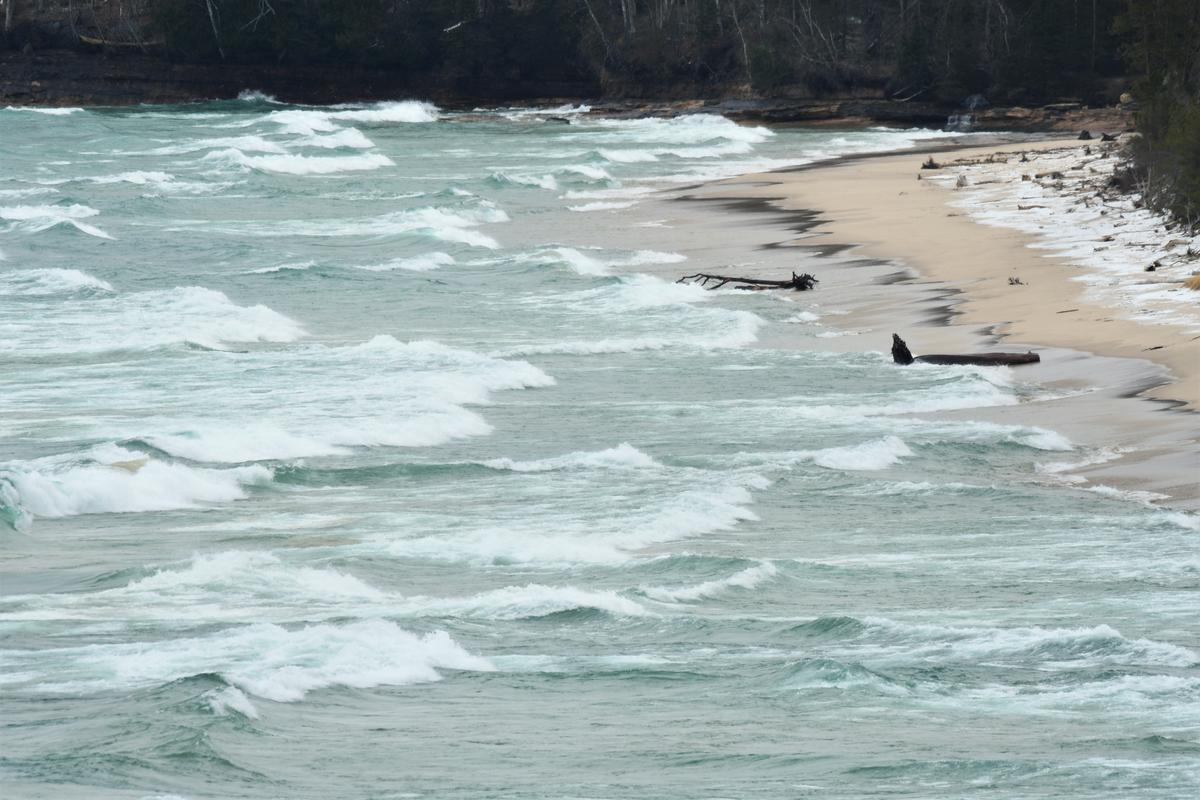
Lake Superior on a winter day. (Photo Credit: Lester Graham/Michigan Radio)
Besides higher lake levels and not as much ice on the Great Lakes, warming can cause other problems.
Researchers around the world measured the warming of more than 240 big lakes. Almost all of them are getting warmer, and Lake Superior is warming more quickly than many of those lakes.
“Temperature ends up being this giant control knob on ecosystems,” said Jay Austin at the University of Minnesota, Duluth.
He said temperature affects nutrient uptake rates in the regions where fish are comfortable spawning. That kind of warming also could make Superior more hospitable to invasive species.
“One of the things that has kept Lake Superior relative to the other Great Lakes less susceptible to invasive species is the fact that it is so cold. And so I think that the impacts on the ecosystem are what we really worry about,” Austin said.
Looking through a window pane at a fisherman on an island near Isle Royale is removing a bit of the fish that researchers can use to determine the age of the fish. (Photo Credit: Lester Graham/Michigan Radio)
When the environment is changing in volatile ways, that’s going to be good for some species and bad for others, he said. Some invasive species might thrive in a warmer Lake Superior.
In the Upper Great Lakes, invasive zebra mussels and quagga mussels brought in by shipping from the Caspian and Black seas have covered the bottoms of Lakes Huron and Michigan by the trillions. They filter out a lot of the nutrients from the base of the food web. That has meant some fish in Lakes Huron, Michigan, and fish that live in the shallower, warmer parts of Superior where the mussels have invaded have suffered. For a couple of decades, whitefish populations have dropped and anglers say sometimes the whitefish they catch are skinny.
Raising whitefish
Brad Silet with the Sault tribe said Native American fisheries experts are trying to figure out what they can do to save whitefish and other kinds of fish important to them.
“Right now, Sault Tribe is doing some experimental whitefish rearing. There’s another tribe (Little Traverse Bay Band of Odawa Indians) doing it also. We are seeing what it would take to raise whitefish and financially what it costs, space costs, so on, so on to see if we can potentially offset any changes to climate change or invasive species that are happening, at least in our area of the Great Lakes.”
The state of Michigan and the federal government long have operated fish hatcheries to raise sport fish. Government agents are now watching the Native American research to see how well experiments in raising whitefish go. Besides being a cultural icon for Native Americans, whitefish bring in much needed money for the tribes and other commercial fishers trying to make a living on the Great Lakes.
Catch more news on Great Lakes Now:
30 Years Later: Mussel invasion legacy reaches far beyond Great Lakes
Michigan is on thin ice. Get used to it, climate experts say.
Mussel-Phosphorus Puzzle: Invasive mussels are reshaping the chemistry of the Great Lakes
“Saving the Great Lakes”: National Geographic December issue explores the lakes and their struggles
API key not valid. Please pass a valid API key.Featured image: Derelict fishing boats once used to fish Lake Superior. (Photo Credit: Lester Graham/Michigan Radio)



